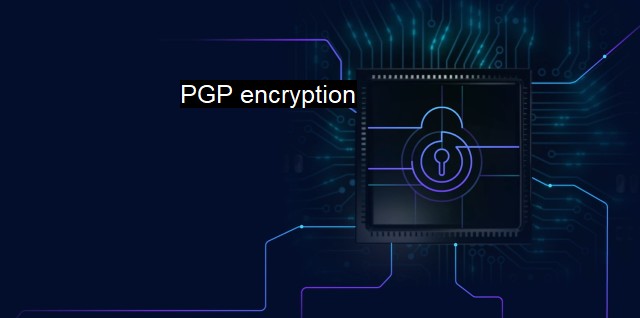What is PGP encryption?
Unlocking the Power of PGP Encryption: Keeping Your Data Secure in the Digital Age
PGP encryption refers to Pretty Good Privacy encryption, a data encryption and decryption program that offers cryptographic privacy and authentication for data communication. It was developed by Phil Zimmerman in 1991 as a method to secure the privacy of online communication.The underlying functionality behind PGP encryption is a variation of the public-key system. The public-key system uses two keys – public and private – to perform its encryption and decryption operations. For communication to be successful, there must be the safe application of a pair of keys. With PGP, the exchange of digital data becomes securer. When a file or message is sent, it is encrypted with the receiver's public key, which can only be decrypted by the receiver using his corresponding private key on his computer.
PGP encryption creates a secure digital envelope around a given set of digital data. Until the envelope is handed over – and subsequently opened – by the intended recipient, it theoretically remains untouchable to any thieves, snoops or adversaries online.
The encryption process utilizes a sequence of operations comprising of data compression, hashing, symmetric-key cryptography, and finally public-key cryptography. The primary reason for data compression is to enhance the transmission speed and save disk storage space. Information is then transfigured using the hashing process into a manageable size.
Symmetric-key cryptography comes next, the data is encrypted with a one-time-only secret key (also referred to as a session key). This symmetric encryption happens because it’s less computationally intensive and hence faster than asymmetric encryption. Public-key cryptography is the last step, where the session key is then encrypted with the public key of the receiver.
One widespread use of PGP encryption is in the protection of emails, with both encryption and hashing algorithms applied to prevent unauthorized access or changes in data while in transit over an insecure network.
In the cybersecurity context, PGP plays a crucial role in safeguarding information from cyber threats and attacks. With rising concerns over cybercrime, protecting sensitive information is increasingly pivotal for individuals, organizations, and governments. PGP encryption can prevent unauthorized access or tampering with sensitive information thus eliminating the risk of an information breach or leakage.
The methodology of PGP is also used in antivirus software. The recursive scanning and data analyzing capabilities in antivirus software parallel the hashing involved in PGP encryption and can be used to safeguard information at a more advanced level by detecting possible threats, malware or trojans under disguise.
As with any security protocol, there is no absolute guarantee. PGP encryption is subject to cracking if weak passwords are used or if a user's private key falls into the wrong hands. Yet, with strong passwords and protective key management, PGP encryption can be considered one of the most potent tools against cyber threats.
The essence of PGP encryption lies in making sure that the information within the digital space we operate is manageable and safeguarded at the same time. Guaranteeing that we can use this space and all the possibilities it brings forth securely and harmlessly.
Now, with the rapid privacy changes globally and the Internet becoming more significant in our day to day functions, the importance of applying PGP encryption to our shared and received data is coming to the forefront. It is rapidly becoming not only an option, but viewed as being an essential tool in cybersecurity. Emphasizing its importance in antivirus software, and how both, combined, can make online transactions, interactions, and overall web browsing deficiency-free and secure.

PGP encryption FAQs
What is PGP encryption?
PGP encryption stands for Pretty Good Privacy encryption. It is a form of encryption used to encrypt and decrypt electronic messages, files, and other types of data. PGP encryption ensures that the data is secure and can only be accessed by authorized individuals.How does PGP encryption work?
PGP encryption works by using a combination of public and private keys. The sender of the message uses the recipient's public key to encrypt the message, and the recipient uses their private key to decrypt it. This ensures that the message can only be read by the intended recipient, as only they have access to their private key.Why is PGP encryption important in cybersecurity?
PGP encryption is important in cybersecurity because it ensures that sensitive data cannot be easily accessed by unauthorized individuals. In the case of a cyber attack or data breach, encrypted data is much more difficult to steal or use maliciously. PGP encryption is especially important for businesses and organizations that deal with sensitive data, such as financial institutions, government agencies, and healthcare providers.How does PGP encryption protect against viruses?
PGP encryption does not specifically protect against viruses. However, it does provide an added layer of security that can help prevent viruses from accessing and infecting sensitive data. If a virus is able to access encrypted data, it will not be able to read or use it without the corresponding private key, which is only accessible to authorized individuals. This can help prevent the spread of viruses and other malware within an organization's network.| | A | | | B | | | C | | | D | | | E | | | F | | | G | | | H | | | I | | | J | | | K | | | L | | | M | |
| | N | | | O | | | P | | | Q | | | R | | | S | | | T | | | U | | | V | | | W | | | X | | | Y | | | Z | |
| | 1 | | | 2 | | | 3 | | | 4 | | | 7 | | | 8 | | |||||||